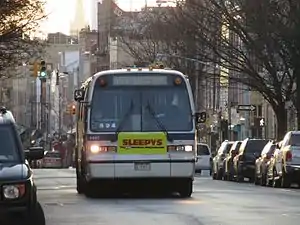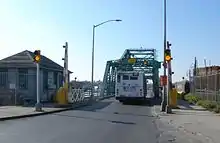Q59 (New York City bus)
The Grand Street Line is a public transit line in Brooklyn and Queens, New York City, running mostly along the continuous Grand Street and Grand Avenue between Williamsburg, Brooklyn and Maspeth, Queens. It then continues down Queens Blvd to the 63rd Drive station. Originally a streetcar line, it is now the Q59 bus route, operated by the New York City Transit Authority between Williamsburg and Rego Park, Queens.
q59
| |||
|---|---|---|---|
| Grand Street Line | |||
 A Q59 bus. | |||
| Overview | |||
| System | MTA Regional Bus Operations | ||
| Operator | New York City Transit Authority | ||
| Garage | Grand Avenue Depot | ||
| Route | |||
| Locale | Queens; Brooklyn | ||
| Communities served | Rego Park, Elmhurst, Maspeth, East Williamsburg, Williamsburg | ||
| Landmarks served | Rego Center, Queens Center Mall, Queens Place Mall, Williamsburg Bridge Plaza Bus Terminal | ||
| Start | Williamsburg, Brooklyn – Williamsburg Bridge Plaza Bus Terminal | ||
| Via | Grand Street and Grand Avenue[1] | ||
| End | Rego Park, Queens – Junction Boulevard & Horace Harding Expressway (Rego Center) | ||
| Length | 6.47 miles (10.41 km) (streetcar line)[2] | ||
| Service | |||
| Operates | 24 hours[1] | ||
| Annual patronage | 2,230,581 (2017)[3] | ||
| Transfers | Yes | ||
| Timetable | Q59 | ||
| |||
Route description
The Q59's western terminus is at the Williamsburg Bridge Plaza Bus Terminal in Williamsburg, Brooklyn. From there, it goes west on Broadway, turning right on Kent Avenue to travel north to Grand Street. However, since Grand Street is not continuous across the Brooklyn–Queens Expressway (BQE), the eastbound Q59 uses Roebling Street, Metropolitan Avenue, and Union Avenue to travel around the BQE.[1][4] At Grand Street, the Q59 turns left, continuing until Gardner Avenue and Metropolitan Avenue (since eastbound Grand Street curves onto Metropolitan Avenue after crossing the Newtown Creek).[4][5] The eastbound Q59 turns right onto Grand Street after a short distance, continuing across the Grand Street Bridge and into Maspeth until another discontinuity forces the Q59 to turn right and then left at Flushing Avenue, meeting up with the Q58.[5] It remains on Grand Avenue until Queens Boulevard, when it turns right while the Q58 goes to Corona Avenue to reach Flushing.[1][5] At Queens Boulevard, the Q59 turns right onto the eastbound service road. It continues along Queens Boulevard until Eliot Avenue, where it turns left along the Long Island Expressway. The Q59 turns right on Junction Boulevard and terminates at 62nd Road, near Rego Center and the 63rd Drive–Rego Park subway station in Rego Park.[1][5]
The westbound Q59 turns right off 62nd Road onto Queens Boulevard. At 90th Street, it makes a right to serve Queens Center and Queens Place Mall. This is so the Q59 can make a turn from the service road into the main road that would otherwise be illegal; it must do this in order to access the left-turn lane at Grand Avenue, which can only be served from the main road.[1][5] The Q59 turns left at 56th Avenue and then right again into the Queens Boulevard main road, using the left-turn lane to turn left onto Grand Avenue.[1][5] The Q59 continues down Grand Avenue until it turns into Grand Street,[1][5] and goes straight down Grand Street until it reaches Union Avenue, where it turns right to go around the BQE.[1][4] The Q59 makes a left at Metropolitan Avenue, a left at Roebling Street, and another right at Grand Street. It goes down Grand Street until Wythe Avenue, turning left there. At Broadway, the Q59 makes another left and continues until it enters the Williamsburg Bridge Plaza Bus Terminal.[1][4]
History

The Grand Street and Newtown Rail Road began building the line in September 1860,[6] and opened the first section, from the Grand Street Ferry on the Williamsburg waterfront to Bushwick Avenue, on October 15, 1860,[7] with a formal opening on October 30. In addition to the Grand Street Ferry, cars soon also served the Broadway Ferry via the track of the Brooklyn City Rail Road's Greenpoint Line on Kent Avenue.[8] By 1865, the line had been extended from Grand Street north along Bushwick Avenue, Humboldt Street, and Meeker Avenue to Penny Bridge.[9] The tracks in Bushwick Avenue were removed after trains started using Humboldt Street instead between Grand Street and Maspeth Avenue on July 19, 1870.[10]
The main line was extended east from Grand and Humboldt Streets over the new extension of Grand Street, opening to the city line (Newtown Creek) on June 9, 1875[11] and to Newtown on August 1, 1876.[12][13] The old line to Penny Bridge became the Meeker Avenue Line.
When the Maspeth Depot opened in 1885, the service was truncated to Maspeth; service from Maspeth to Elmhurst became a shuttle. (Later it became part of the Flushing–Ridgewood Line). The Brooklyn City Rail Road leased the Grand Street and Newtown on May 1, 1890.[14][15] Buses were substituted for streetcars on December 11, 1949.
On November 6, 1954, the NYCTA proposed to eliminate weekday service between 7 p.m. and 5 a.m. and all weekend service to cut costs. Free transfers would have been provided between the B53 and B57.[16][17] In the fall of 1975, the bus route was extended from 72nd Street in Maspeth east to Elmhurst and southeast on Queens Boulevard to Rego Park.
In January 2008, 24/7 service was added to the Q59 route.[18] In August 2009, southbound service was rerouted from Kent Avenue to Wythe Avenue due to the conversion of Kent Avenue to a one-way northbound street to restructure the bike lanes on that street.[19] Service was eventually extended to the Williamsburg Bridge Plaza Bus Terminal in 2010, and in September 2016, the eastern terminus of the route was relocated to 62nd Drive to avoid a hazardous U-turn at 63rd Road/63rd Drive, as well as provide a closer connection to Rego Center.[20]
See also
- Flushing–Ridgewood Line (Q58)
- Junction Boulevard Line (Q72)
References
- MTA Regional Bus Operations. "Q59 bus schedule" (PDF).
- "Public Notices". Brooklyn Daily Eagle. May 19, 1949. p. 29. Retrieved December 26, 2015 – via Newspapers.com.
- "Facts and Figures". mta.info. August 28, 2011. Retrieved January 19, 2016.
- "Brooklyn Bus Map" (PDF). Metropolitan Transportation Authority. October 2020. Retrieved December 1, 2020.
- "Queens Bus Map" (PDF). Metropolitan Transportation Authority. September 2019. Retrieved December 1, 2020.
- Brooklyn Daily Eagle, Began at Last, September 4, 1860, page 3
- Brooklyn Daily Eagle, Completion of the Grand Street Rail Road, October 16, 1860, page 3
- Brooklyn Daily Eagle, The Grand Street Railroad, October 31, 1860, page 3
- Brooklyn Daily Eagle, Particulars About Our City Rail Roads, August 10, 1865, page 2
- Brooklyn Daily Eagle, Change in the Grand Street Railroad Route, July 19, 1870, page 2
- Brooklyn Daily Eagle, June 9, 1875, page 4
- Brooklyn Daily Eagle, The Grand Street Railroad, August 1, 1876, page 4
- Brooklyn Daily Eagle, Grand Street Railroad, August 2, 1876, page 4
- Brooklyn Daily Eagle, Ratified the Lease, April 28, 1890, page 6
- Brooklyn Daily Eagle, Takes Possession of the New Lines, May 1, 1890, page 6
- "Transit Authority Proposes Cut In Local Bus Service" (PDF). Queens Ledger. November 11, 1954. Retrieved January 3, 2020.
- "'Brooklyn' Program Hits Queens: TA Slashes Service On Two Bus Lines" (PDF). Long Island Star-Journal. November 6, 1954. Retrieved January 3, 2020.
- Naanes, Marlene (September 24, 2007). "Expanded bus service on tap". AM New York. Archived from the original on October 17, 2007. Retrieved July 19, 2016.
- "Southbound Q59 Rerouted in Brooklyn". mta.info. Metropolitan Transportation Authority. July 29, 2009. Retrieved March 13, 2020.
- "Transit & Bus Committee Meeting" (PDF). Metropolitan Transportation Authority. July 2016. Archived from the original (PDF) on August 19, 2016. Retrieved September 10, 2016.
External links
 Media related to Q59 (New York City bus) at Wikimedia Commons
Media related to Q59 (New York City bus) at Wikimedia Commons- Horse Car Rest Stop - Historical Sign
